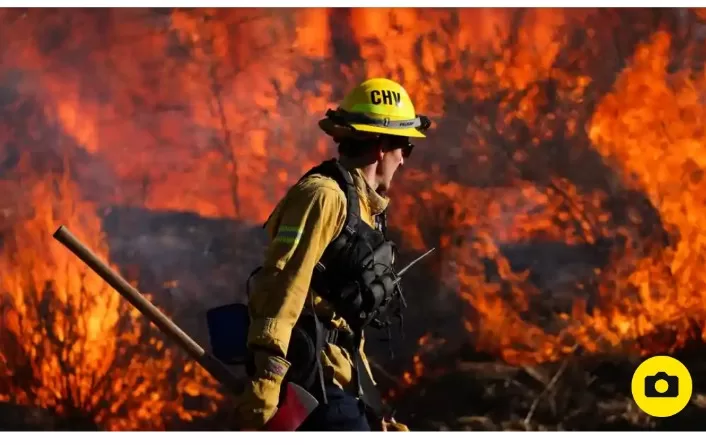A wildfire, fanned by strong Santa Ana winds, has swept through rural areas in the southeast of Los Angeles, compelling approximately 4,000 residents to evacuate from their homes, as confirmed by fire authorities.
As of Monday, a fire spokesperson, Jeff LaRusso, reported that evacuation orders covered around 1,300 homes and affected roughly 4,000 residents. On Tuesday morning, officials confirmed that evacuation orders and warnings remained in effect.
The wildfire has led to the destruction of three structures and inflicted damage on six others, although it remains uncertain whether any of these structures were residential. While the region is sparsely populated, it contains horse ranches and a sizable mobile home site.
No reports of injuries have emerged, and investigations are underway to determine the cause of the wildfire.
One affected homeowner, Luis Quinonez, humorously remarked that his burned house was “not for sale anymore,” despite losing his property and a collection of 13 vehicles intended for sale. Fortunately, his second house across the street remained untouched, and none of his pets were harmed.
The terrain, marked by pink streaks from aerial fire-retardant drops, displayed signs of successful firefighting efforts, with scorched earth stopped by a white picket fence surrounding a large horse stable. A nearby olive oil company also escaped damage.
Notably, this wildfire represents the first significant Santa Ana wind condition observed in Southern California this season. These strong, hot, dry winds laden with dust typically move towards the Pacific coast from inland desert regions during the fall. They have previously fueled some of California’s largest and most devastating fires.
California has been relatively fortunate with a relatively quiet fire season due to a rainy winter that lifted the state out of drought, leaving abundant snowpack that consistently hydrated vegetation and soil. The wet weather, including the effects of Tropical Storm Hillary in August, significantly reduced the risk of severe wildfires.
However, the wind events this week marked the arrival of the season’s first substantial winds. On Monday, winds blowing at speeds of 20 to 25mph, accompanied by powerful gusts, propelled the flames and embers through dry grass and brush, rendering them highly combustible for the fire.
While the winds are expected to ease somewhat overnight, fire crews are working to contain the blaze. Jeff LaRusso noted, “Wind trumps everything,” emphasizing the significance of weather conditions in firefighting outcomes.
The National Weather Service (NWS) issued a wind advisory for the region, predicting winds of 15 to 25mph with gusts reaching up to 50mph, with the strongest winds expected in foothills and adjacent valleys.
Conditions improved on Tuesday, as NWS announced that wind advisories would expire by 8 pm PT on Tuesday or even earlier. Red flag warnings for critical fire weather conditions in parts of Los Angeles and Ventura counties were also anticipated to be canceled by early afternoon.
Southern California Edison, the local utility, considered power cuts for 144,000 customers across six counties to mitigate the risk of electrical equipment damage during high winds, although a relatively small number of customers were initially affected by these public safety power shutoffs.
Experts have issued warnings that despite the current favorable conditions, California remains vulnerable to more challenging situations later in the fall if weather patterns align with the dry fuels that still exist. Lenya Quinn-Davidson, fire network director for the University of California’s division of agriculture and natural resources, emphasized the potential for a serious fire season if unfavorable conditions arise.
As California remains watchful for wildfire threats, the region’s recent experiences serve as a reminder of the persistent challenges posed by wildfires and the critical importance of preparedness and prevention measures.







